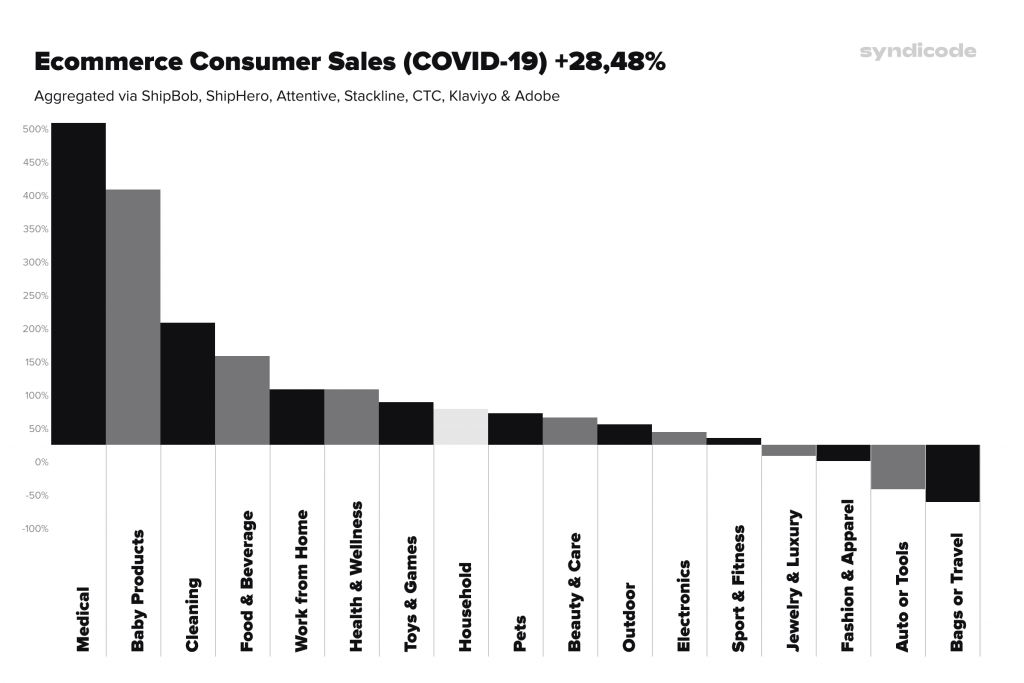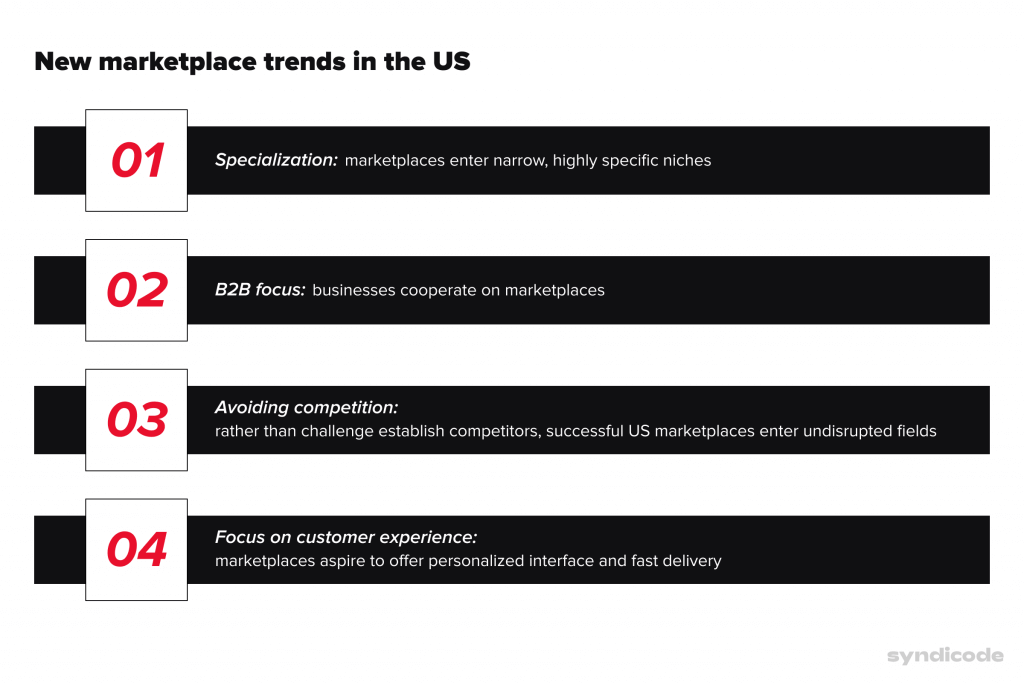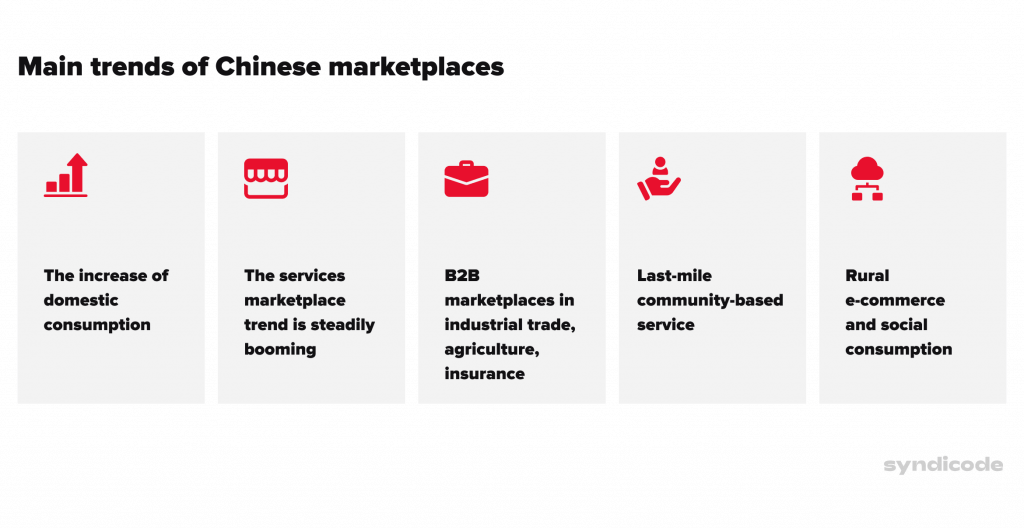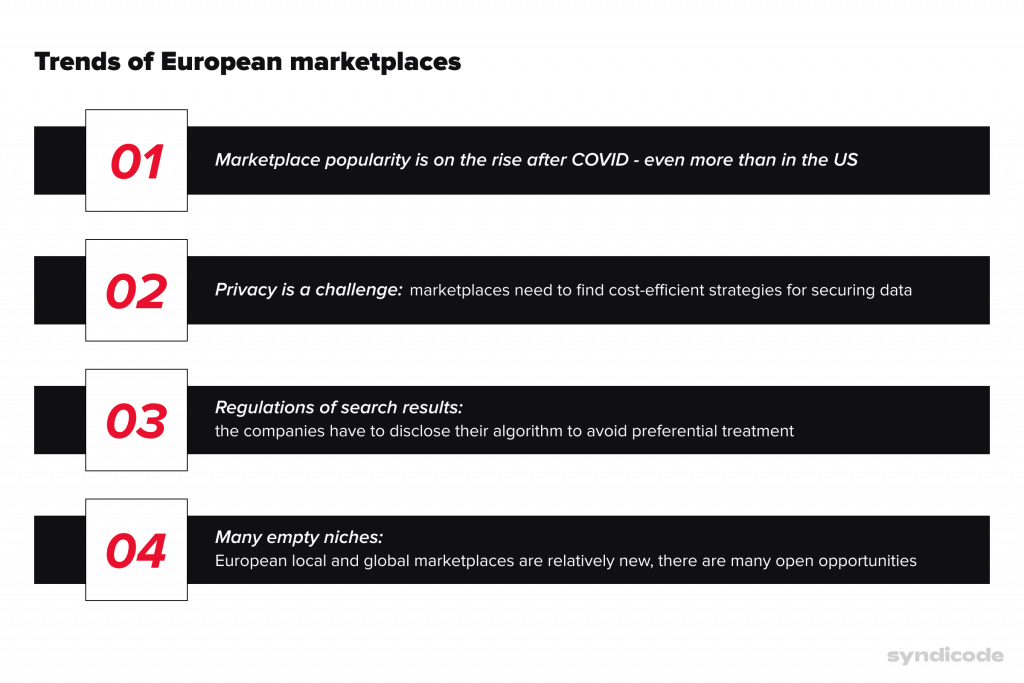Online marketplace revenue is booming all over the world.
We at Syndicode noticed that U.S marketplaces have demonstrated remarkable user growth and revenue increases – but it’s not a local trend. The same patterns are happening in Chinese, European, Australian, Indian, and other marketplace geographies.
In this research, we explored the dynamics of the best online marketplaces’ growth in different markets. Based on our extensive experience in the marketplace development process, we analyzed industries, user dynamics, revenue, and market trends by looking at new and established platforms.
Post-COVID impact on the marketplace industry
The most popular commercial industries have been actively going online during the last five years. Most of them just needed a push – which finally came to shore in 2022. COVID pandemic hit offline businesses hard – in lock-downs and self-isolation, customers discovered and re-discovered online shopping convenience.
In the health, housing, and food market, the impact of COVID quickly caused businesses to increase the digitalization pace. In specific needs, like travel, online penetration reached more than 50%. Approximately the third of the fashion market has been going online.
The situation around marketplaces and ecommerce platforms in 2022
The boom of online shopping causes users to consider other ways of shopping. The online marketplace industry entered the year with a high growth perspective, but as the year progressed, new opportunities emerged.
- New fields embrace marketplaces – but more products than services. COVID-lockdown convinced people to consider spending online. Fast delivery, no need for personal contact, and rapid digitalization of many fields opened new possibilities for businesses and customers.
- Safety and speed are above all. Marketplaces offer a wide selection of product providers. Buyers do not depend on a single centralized provider; instead, they want to have a rich selection of offers.
- Community support is essential. COVID pandemic reminded customers of the importance of communication and mutual help. Now people are more than ever open to put trust into online communities.
Offline marketplaces, trade shows, expositions were either canceled or moved online due to COVID. Events that gathered large communities of buyers are now inaccessible. The niche is empty – and it’s up to marketplaces all over the world to fill it up.

Best online marketplaces in the United States
Already back in 2018, the total sales on online marketplaces exceeded 473 billion dollars. Each year, sales increase by approximately 100-200 billion dollars. In 2022, projected net revenue of Amazon.com’s e-commerce and service than 356 billion.
Let’s take a look at the most popular U.S marketplace and summarize practical insights, useful for business owners who plan to build a marketplace.
Amazon
Amazon is one of the world’s largest top online marketplaces and the most prominent online retailer in the United States. The platform hardly needs an introduction – let’s cut to actionable insights right away.
- Multi-layered target audience: the primary audience segment is the final customer, but the platform also serves distributors, manufacturers, developers, sellers.
- Complex infrastructure: Amazon is an example of successful penetration across multiple niches and locations. While it’s a big competitor for new platforms, Amazon also proves that any marketplace selling activities can be digitized.
- Amazon Prime showed successful adoption of annual membership. American startups can successfully implement mo they and manual memberships into their business model. Giving users premium status and offering additional value is an excellent way to build a long-term user community.
Business owners who plan to start a top online marketplace in the United States should begin by exploring Amazon’s offers in their niche. Analyzing demand, trends, reviews, and sellers strategies will get you a clear idea of demand and supply.
eBay
The second most popular US marketplace is eBay – and just like Amazon, it doesn’t need much introduction. Despite the platform’s long-honed reputation, business owners should disregard eBay trends in their marketplace research. By analyzing eBay’s updates and growth strategies, we pinpointed the following insights.
- Loyal communities: 61% of eBay users right now are 35-64-year-old users. They are devoted to the platform’s features and offers and actively participate in marketplace activities.
- Not enough engagement among younger audiences, which is a significant threat. While maintaining a dedicated audience a good thing, eBay failed to capture the audience of Millennials and generation Z. If the trend continues, we might soon see the decline of the platform.
It’s essential to know your target audience well and keep its interest. However, if you are just planning to build a marketplace, make sure that your features and positioning can appeal to a younger audience.
When we build ecommerce platforms, we always tell our clients about the importance of the product’s relevance.
Walmart.com
Walmart’s online marketplace is one of the most popular ones in the American market. It’s also a friendly reminder that even all-online businesses have to compete with known offline retailers.
- Walmart cooperates with manufacturers and distributors, providing them with infrastructure to set up an online store, connect with users, set prices, and build online inventory.
- With Walmart’s resources, they can manage customer support, shipping, logistics.
- As compensation, the marketplace takes a referral fee for each sold item.
- By refusing typical monthly and annual-subscription models, Walmart opts for a more flexible method. Marketplace owners pay fees only for what they sell. Walmart and business owners share the common interest of selling as much as possible.
This transparent and flexible cooperation between sellers and the marketplace’s team is famous not just in the US marketplaces but also in the world. For Walmart, transferring some of its operations is a way to increase their reach and get new providers and customers.
Best new ecommerce platforms in the US
Let’s take a look at how new marketplaces applied these trends and developed their insights to enter the market and grow their business during COVID and in the post-pandemic world. We aren’t out of the woods yet – new waves can strike anytime – so hopefully, these striving companies will give us examples of stress-resilient business models and execution.

Xometry
Xometry is a manufacturing marketplace that recently raised more than 75 million to grow its platform. The service provides manufacturers, engineers, and companies worldwide with unique manufacturing pieces, devices, scientifically-complex hardware, and instruments.
The platform connects multiple manufacturers, letting them necessary materials for their activities. Buyers can be people who have their businesses, large companies, and manufacturers.
The relevance: during COVID, many manufacturing companies suspended their activities or were shut down. Xometry covers the market need by providing necessary details asap.
Inspectify
This home renovating and the retail-buying marketplace was founded by a founder who bought and renovated multiple properties and saw multiple unaddressed market needs in the process. The ecommerce platform allows home buyers to connect to real estate agents, book house inspections, and receive consults on their home resonating journey.
The top online marketplace recently graduated from Y Combinator and raised impressive funding. Inspectify offers consulting and services, whereas most competitors connect directly to house sellers, not home inspectors.
The relevance: identifying the lack of selling areas of expertise is the right way to bring value to your marketplace community. You can start by identifying your personal experience and determining where professional consultation could solve the issue.
The Zebra
It’s an Austin-based insurance marketplace that raised more than $38 million in Series C. The platform allows car owners to compare offers of insurance. Users can analyze side to side up to 100 providers and pick the best offer.
The company also provides personal customer supports – users can connect Zebra agents to pick the best insurance deal. The market of car insurance has been highly valued by investors all over the world – we’ve seen a range of marketplaces getting a high evaluation.
The relevance: marketplaces that allow comparing offers, especially in the insurance market, are hot on the market. If you are planning on building a marketplace, consider incorporating comparison functionality.
The bottom line on online marketplaces in the US
Now that we’ve analyzed US online marketplaces let’s summarize market trends’ and tendencies before moving on to other locations.
- Amazon is not the only marketplace. Business owners who want to start a marketplace are often concerned that they will have to compete with Amazon, which is highly relevant in the US. However, you don’t have to compete with the best ecommerce platform if you manage to tap into a unique niche or offer an out-of-the-box solution. The analysis of new popular marketplaces shows that they found a new approach to the problem without competing with e-commerce giants.
- The US market offers new user experiences. According to the New York Post, Americans, in general, spend 20 days a year stuck in traffic. A large percentage of commuters prefer to shop online during traffic jams.
- New technology trends: US marketplaces have been actively adopting Progressive Web Applications. We wrote a post on PWA development – check it out; it’s a massive trend in web development overall, but specifically, in marketplaces.
- Appealing to Gen Z and millennials is a must. You need to equip your platform with the relevant functionality to attract new generations who are reluctant to use existing big platforms. This could very well be your chance to outrun older competitors.
The U.S. ecommerce website market is vast, but Asian and European platforms make up quite a competition. There are many trends yet left to explore when it comes to American marketplaces – while considering international competitors, too.
Online marketplaces in China
The Chinese ecommerce website market is the largest in the world. In 2019, Chinese online sales were reported to be at least 2 billion dollars, three times larger than those of the US market.

The marketplace market follows the same trend. The three most prominent e-commerce players – Alibaba, JD.com, and Pinduoduo, all have marketplaces. They connect sellers and buyers worldwide, not just in China, in cooperation with manufacturers and distributors.
Let’s analyze three giants of China’s online marketplace market, as well as three new promising startups. Just like US marketplaces, Chinese marketplaces expand across multiple regions.
Alibaba
Alibaba became the leading Chinese e-commerce provider and a global example of marketplace success. In a paper on examining the growth of Alibaba, university professors Shan-Ling-Pan and Barney Tan explored its success. Most points were highly exciting and applicable to different markets and niches – so let’s take a look.
- The marketplace as a way to export national products. Early on, Alibaba positioned itself as a global market for connection to the worldwide market. Doing this across many niches and fields might be difficult with large competitors, like Amazon, but smaller businesses can be this across 1-2 niches. Think about what goods and services you can present to global markets.
- Lowering the bar. Alibaba became popular because it allowed small and medium businesses to access international audiences. Think about ways in which you could help small businesses and individuals accomplish ambitious goals.
- Educating users. Alibaba released a lot of educational materials and tools that facilitated online sales and transactions. Not all users are equally acquainted with technology, and it’s the job of the marketplace to support and teach users.
Alibaba positioned itself as a cheap destination where pretty much everything is available. They carefully analyzed benefits that they can provide to local and international users – and it paid off.
JD.com
The marketplace is the most extensive technology and innovation marketplace in China and one of the world’s biggest tech platforms.
- The marketplace was initially created as a magneto-optical store but later went on to explore a more mainstream niche – computers, phones, electronic devices.
- Apart from innovating the functionality and interface of the marketplace itself, the company has been an active investor in AI, technology, drone delivery, Cloud infrastructure and other innovative fields.
If you are considering starting as a technology-based marketplace, take a look at JD.com. The platform offers interesting cases for cooperation with distributors and clients, but it’s also one of the most affordable platforms.
Pintoduo
This relatively new marketplace is quickly becoming an emerging e-commerce platform in China. The forum demonstrated remarkable user growth, even getting ahead of Jot.com. The thing is, Pintoduo introduced a unique concept of team purchasing and social e-commerce to a traditional marketplace business model.
- The platform targets lower-income buyers, many of whom are located in rural areas.
- In a more collectivistic China, users are much-oriented on making purchases together and splitting the costs – so the business model fits users’ needs and culture perfectly.
- For purchasing together with friends, buyers get huge discounts – up to 90%.
Pintoduo’s strong referral program and emphasis on bulk purchases contributed to rapid growth (even if that doesn’t translate to rapid revenue increase yet).
Emerging Chinese marketplaces
China is conquering the B2C market and showing the way for marketplaces in narrower, more specialized niches. Although Alibaba sits at the top of the most popular BSb marketplaces, there are a lot of smaller, recently emerged startups.
Tiebaobei
The startup that provides buyers with second-hand engineering machines has raised CN¥300 million. The platform’s team has ambitions to push the marketplace to the international level, making it a global service for second-hand machinery purchases.
HAIZOL
HAIZOL is another industrial b2b marketplace that focuses on trading industrial components and helping manufacturers get necessary parts. The company has raised for than $20.9 million in investments.
Just like US startups need to avoid competition from marketplace giants like Amazon and eBay, Chinese startups have to choose specialized sectors to prevent large e-commerce players.
Zhenkunhang
Zhenkunhang is a marketplace that connects buyers to sellers of lubricants, fasteners, adhesives. It’s a Chinese version of Grainger in the United States- a famous American platform for purchasing industrial products.
Meicai
Another significant segment of the online marketplace market in China, together with the industrial sector, is agriculture. Meicai is one of China’s biggest online shopping platforms that raised more than 750 million dollars in investments. The platform connects farmers and sellers form rural areas to businesses and individuals.
A bottom line on online Chinese marketplaces
Ecommerce website growth in China will continue in 2022 – however, business owners who want to enter the market need to consider crucial trends and dynamics.
- The increase of domestic consumption requires marketplace businesses to keep targeting individuals. To win the competition over established platforms, they can pick narrow niches and offer unique value.
- The services marketplace trend is steadily booming and this process swill continue. This trend is especially noticeable in smart technology and consultancy.
- B2B marketplaces in fields like industrial trade, agriculture, insurance are rapidly growing.
- Last-mile community-based services – communities based around marketplaces are often revolved towards supporting local businesses and providers. Buyers want to get a product quickly from a vendor nearby.
- Rural e-commerce and social consumption are growing. Small farming businesses and individual activities are quickly getting digitized. Business owners can enter this niche and offer a new perspective on agricultural buying and selling and embrace referral programs.
Chinese marketplace trends are marked by rapid development and expansion in agriculture and manufacturing. Unlike individualistic Western businesses, Chinese marketplaces are open to help communities and encourage buyer cooperation. The case of Pintoduo shows that social buying is a real trend in China.
European marketplaces

Europe’s e-commerce and Internet penetration is steadily growing. One of the main advantages of European online marketplace platforms is creating a multi-national community and offering free movement of goods and people across the EU. This economic benefit allows marketplace teams to scale their services and reach more users quickly.
To understand the trends in the market, we analyzed the most famous European marketplaces. Mostly, we looked at businesses that are present in many countries and have active international communities.
BlaBlaCar
BlaBlaCar is a French-based top online marketplace for sharing car drives. In the midst of sharing economy development, BlaBlaCar tapped right into the trend with its business model. Now the startup is supported in 22 countries, covering almost the entire Europe.
Insights for marketplace development
- The systems of reviews and verifications: users cna rate driver profiles, communicate directly with drivers, and track the progress of their orders. Security and transparency are fundamental in the process of booking a ride.
- The system is comfortable for drivers and riders alike. Shared-economy marketplaces should create a trusted environment for both sides. BlaBlaCar succeeds at this by offering great support, profile verification methods, and background check features.
- The model of BlaBlaCar is commission based – the team receives about 20% from every booking.
In the case of BlaBlaCar, community and reputation are crucial for long-term success. On the software development level, such an environment is built with powerful admin panels, verification features, robust security algorithms, and direct connection.
Zalando
Although Zalando is technically a UK-based company (so not the EU anymore), this ecommerce business successfully penetrated multiple European markets. Now it’s a top marketplace for fashion brands and buyers.
Insights for marketplace development
- Zalando stands out with its clean design and unique user experience features. Here, users can receive clothes first, try it on, and pay after confirming the right fit.
- Such functionality lets Zalando compete with Amazon and other global platforms.
- Zalando put trust and transparency at the core of its functionality, which is how it stands out from more “corporate” communities.
If you plan to start a marketplace in the niche that’s heavily saturated with intense competition, think about how you can go above and beyond in providing the best customer experience. Often, it starts with taking risks – like offering users unique bonuses and features.
Carrefour
Like the US, the European marketplace selling industry has players who first established their names as offline retailers. Carrefour, a big shopping center corporation, has an online marketplace. Like Walmart, they p[artner manufacturers and distributors and use their resources to sell new products.
Insights for marketplace development
- If you need established infrastructures and names for your marketplace, you can consider partnering in physical stores and retail centers. They will provide you resources while you will connect them to buyers and provide international exposure.
- Embrace coopering with physical stores rather than treating their businesses as a competition. Sure, big companies might choose to work with their online marketplaces, but small and medium companies are likely to jump on board.
Leveraging the reputation and infrastructure created by offline shopping centers and stores is an excellent way to generate reputation and gain traction quickly. However, if you are choosing this business model, consider the marketplace’s value. If a shop already has an efficient infrastructure, your offer has to be valuable to attract partners. An excellent way to start is by building a robust platform with tracking tools, payment systems, and robust admin panels.
New European marketplaces
Like all over the world, the boom of marketplaces in Europe has been extraordinarily active in smaller yet unoccupied niches. Businesses don’t want to compete with large e-commerce platforms and instead prefer to look for creative solutions to lesser-known platforms. Aiming for smaller markets makes it easy to define the target audience and reduces the competition.
Let’s look at what online marketplace platforms are conquered by emerging European marketplaces and see what we can learn here.
Spreadshirt
Spreadshirt is a German online marketplace for creating personalized accessories and T-shirts. Sellers can present their designs, attract buyers into their shops long-term, and reach very particular audiences.
The positioning or business model on their own aren’t that creative. Still simple, intuitive execution made the platform attractive to sellers and buyers from different European countries.
HLPRS
HLPRS is Netherlands-based online marketplace sites that connect buyers to helpers – users who provide everyday services (babysitters, dog walkers, cleaners, gardeners, etc.). The platform takes full responsibility for the ordering process, as well as a result. Both clients and helpers can connect support systems, create invoices, leave reviews, and plan their schedules.
For service and hiring marketplace, communication and management is a priority both for sellers and buyers. This is why HLPRS offers a robust CRM, admin panel, management add-ons, and scheduling tools. The basic functionality includes separate registration flows for buyers and sellers, client search, reminders, notification, schedules, reports, invoices, feedback, and client support.
Movinga
Movinga is a German-based best ecommerce platform that helps users with moving to another house. Buyers connect to moving experts and companies and verify the quality of their service. Buyers know that providers on the platform have an established reputation, see the reviews, and sort companies by rating.
To gain traction, the startup launched an interactive game, which landed it a spot in the list of Germany’s most innovative startups in 2018. The team also developed a user funnel for buyers and sellers, making an intuitive flow.
The bottom line on European online marketplace platforms
Trends of the European online marketplace market are similar to American, but not the same.
- Regulation and legal oversight. In 2019, European legislators published new projects aimed at online marketplaces and app stores.
- The companies are obliged to publish all the internal details on preferential treatment to products, search engine algorithms, the logic behind search ranking, and review verification.
- Privacy limitations. GDPR alone made it harder for business owners to get personal data from users, but we could likely be looking at future similar legislation in 3-5 years. These limitations create challenges for marketing, obstruct specific business models, and require businesses to invest more data protection resources.
This is why we recommend cooperating with developers who have experience of building marketplaces on the European market. They are aware of privacy regulations and legislative differences and will build a functionality that complies with legal requirements.
Conclusions
Each geographical market has its trends and characteristics. This is why, before making a marketplace, a Syndicode team conducts an in-depth discovery phase intending to understand the market from the inside. We review competitors, analyze future functionality, check the business model.
When you build a marketplace, you are also creating a community. The rules of creating communities depend on local culture, business trends, and users’ mentality. If you’d like us to start building a marketplace that fits your local market like a glove, contact our developers and business analytics specialists.
